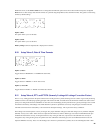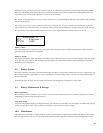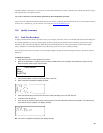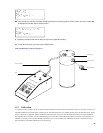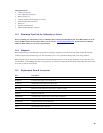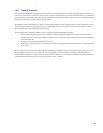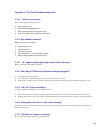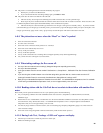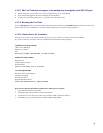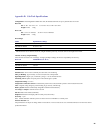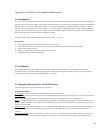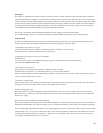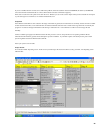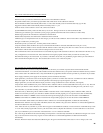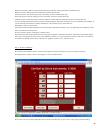30
1A The piston is not reaching the bottom in the time allotted by the program.
•
Push any key to return to the Read Screen.
•
If you want the Cal=Trak to start taking readings again, press Read or Auto.
1B The piston does not return to the bottom of the cell at all.
•
The flow rate may be too high for the cell being used, make sure that the flow is in the specified range.
•
Water vapor may have condensed inside the cell if the cell has been moved from one location to another. Allow the cell to come
to ambient temperature and the piston should fall naturally as the condensation evaporates.
•
The flow cell may have been used with a gas other than air or nitrogen. Some gases are naturally “sticky”. If you have used the
cell with another gas, run nitrogen gas to the inlet port at a pressure below 5 psig while keeping the outlet port open to atmosphere. The
nitrogen gas will slowly purge out the “sticky” gas previously used and the piston will return to the bottom of the cell.
A-8.0 The piston does not move when the “Read” or “Auto” is pushed
1 Is the cell connected to the base?
2 Is a flow source connected?
3 Is the flow source connected correctly (Pressure vs. Vacuum)?
4 Is the flow source inadvertently set too low?
5 Are any of the ports sealed?
6 Are any of the tubes pinched?
7 Are any of the connections loose or leaking? This can happen especially easily with Swagelok fittings.
8 Can you hear the valve working? If not, contact Sierra.
A-9.0 When taking readings, the flow seems off.
1 Are any of the connections loose or leaking? (Swagelok fittings are especially prone to this.)
2 Are any of the tubes pinched?
3 Is the gas constant set to the correct number? See Section 8.1, Setup Menu 1, Calibration ID #, Gas Constant, Calibration
Type.
4 If you are using the cell within bottom 10% of its flow rating with a gas other than air, check to make sure the LCF
(Leakage Correction Factor) is set correctly. See Section 8.6, Setup Menu 6, Leakage & LCF.
5 Make sure your standardized temperature matches the current DUT. If a standardization temperature of 21C is used with
a DUT having a standardization temperature of 0C, an error of approximately 7.5% can result.
A-10.0 Readings taken with the Cal=Trak do not correlate to those taken with another flow
meter
Please check previous question. If that does not solve your problem, please check the following:
1 Are you comparing volumetric flow with standardized flow? See Section 8.1, Setup Menu 1, Calibration ID #, Gas Constant,
Calibration Type.
2 If both units are set to “Standardized”, are both units set to the same standardized conditions? See Section 8.3, Setup Menu 3, Temp.
Correction Factor, Temp. & Pressure Formats. If a standardization temperature of 21C is compared against a standardization
temperature of 0C, an error of approximately 7.5% can result.
3 Are there any large containers in the flow stream, such as extra tubing, large damper(s), Magnehelic gauges, etc.? These items can
cause inaccurate readings.
4 Is the flow source strong enough that it will not be affected by small variants of back pressure?
A-11.0 During Leak Test, “Leakage > 9.999 ccm” appears on display
1 Check for poor connections on either the pressure or suction port.
2 Make sure all fittings are tight.



